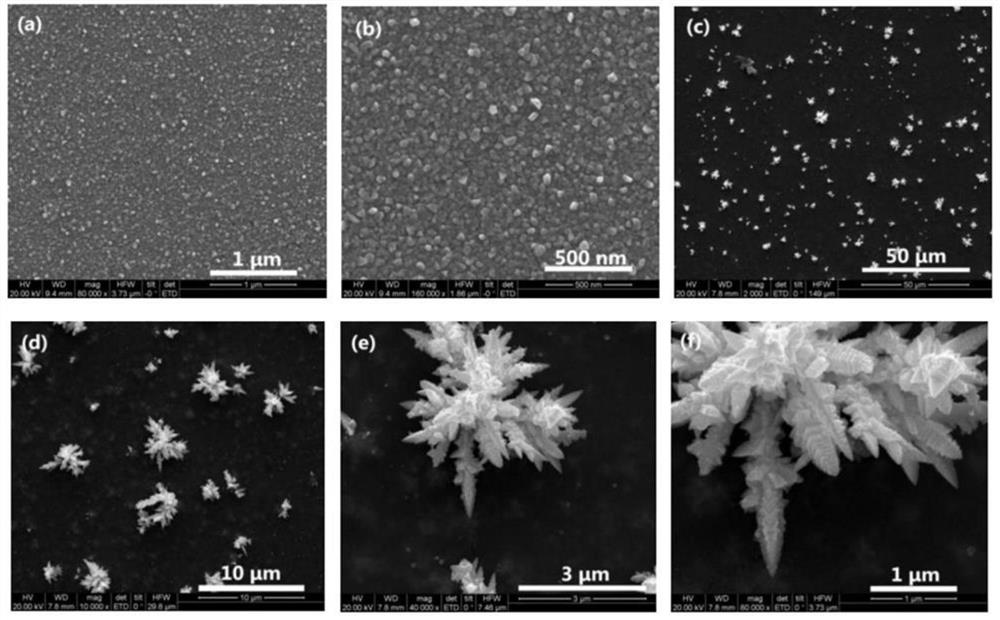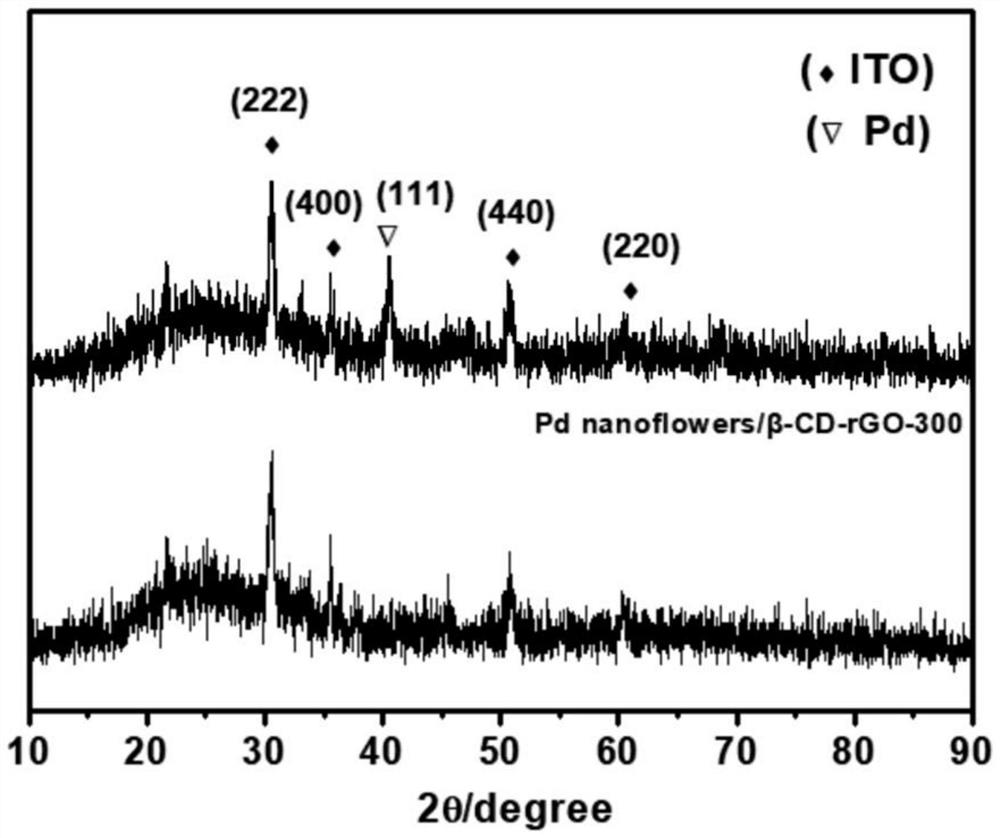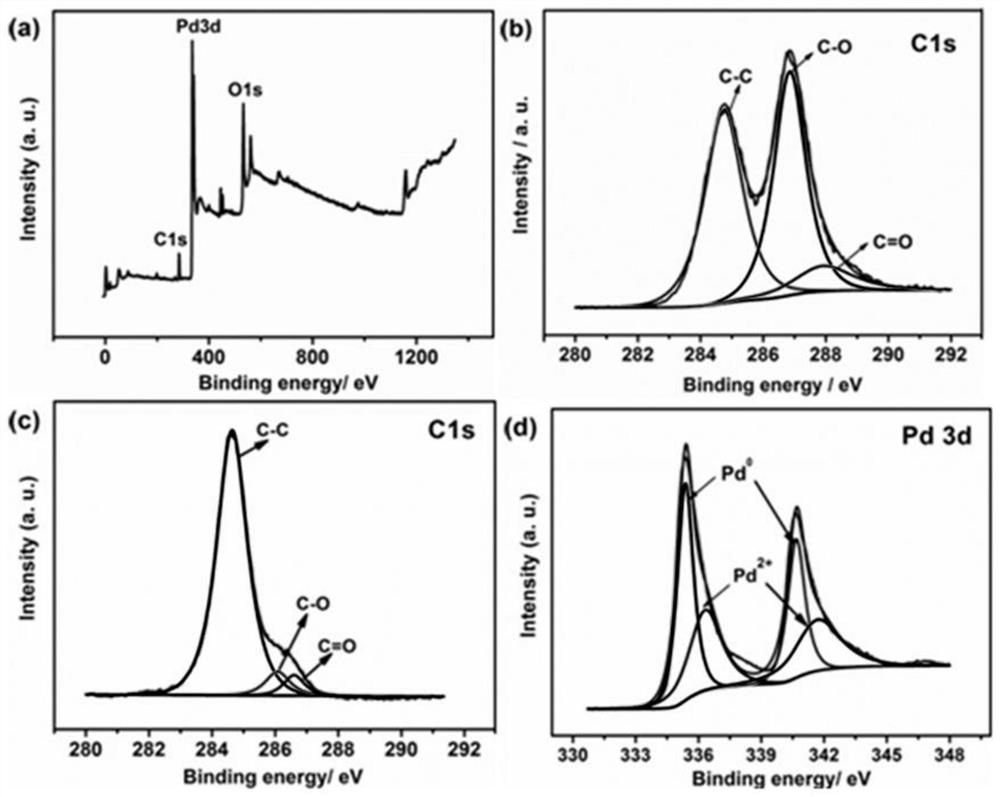Preparation method of beta-cyclodextrin functionalized graphene Pd-loaded nanoflower catalyst and application of beta-cyclodextrin functionalized graphene Pd-loaded nanoflower catalyst in formic acid electrooxidation
A technology of cyclodextrin and nanoflowers, applied in nanotechnology, nanotechnology, nanotechnology for materials and surface science, etc., can solve the problem of low activity of Pd catalyst, achieve superior electrocatalytic performance, simple preparation method, The effect of high catalytic activity
- Summary
- Abstract
- Description
- Claims
- Application Information
AI Technical Summary
Problems solved by technology
Method used
Image
Examples
preparation example Construction
[0025] A preparation method for a β-cyclodextrin functionalized graphene-supported Pd nanoflower catalyst for formic acid electrooxidation, the method is prepared by a constant potential electrodeposition method, and the specific steps are as follows:
[0026] 1) Weigh 0.25 mg of pre-synthesized β-CD-rGO and dissolve it in 1 mL of water, and ultrasonically disperse for 1 hour to make the solution evenly dispersed;
[0027] 2) Use a pipette gun to drop the solution obtained in step 1 onto the glassy carbon electrode, drop 0.25 μL each time, drop 6 times, the total amount of dropping is 1.5 μL, and dry naturally at room temperature;
[0028] 3) After the β-CD-rGO modified glassy carbon electrode obtained in step 2 is dried, add 1 μL of 0.5wt% nafion solution dropwise, and dry under an infrared lamp for 10 minutes;
[0029] 4) Place the substrate obtained in step 3 in a 3mmol / L H2PdCl4 solution, deposit at a potential of -0.2V for 100-500s, wash with water three times after the d...
Embodiment 1
[0031] 1) Weigh 0.25mg of β-CD-rGO and dissolve it in 1mL of water, and disperse by ultrasonic for 1 hour to make the solution evenly dispersed. The resulting solution was added dropwise to a glassy carbon electrode, with a total volume of 1.5 μL, and dried naturally at room temperature. After drying, 1 μL of 0.5wt.% nafiion solution was added dropwise, and dried under an infrared lamp for 10 minutes.
[0032] 2) Place the substrate obtained in 1) in 3mmol / L H 2 PdCl 4 In the solution, deposit in the potential range of -0.2V for 100s, wash with water three times after the deposition, and blow dry with nitrogen to prepare the β-cyclodextrin functionalized graphene-supported Pd nanoflower catalyst, which is denoted as Pd nanoflowers / β-CD-rGO-100.
[0033] The prepared catalyst was placed in 0.5mol / L H 2 SO 4 Electrochemical tests were carried out in +1.0mol / L HCOOH solution to study the catalytic performance of the catalyst for the electrooxidation of formic acid.
Embodiment 2
[0035] The deposition time in step 2) in Example 1 was changed to 200s, other steps were the same as in Example 1, and the obtained catalyst was recorded as Pd nanoflowers / β-CD-rGO-200. The catalytic performance research of the electrocatalyzed formic acid oxidation is the same as that in Example 1.
PUM
 Login to View More
Login to View More Abstract
Description
Claims
Application Information
 Login to View More
Login to View More - R&D
- Intellectual Property
- Life Sciences
- Materials
- Tech Scout
- Unparalleled Data Quality
- Higher Quality Content
- 60% Fewer Hallucinations
Browse by: Latest US Patents, China's latest patents, Technical Efficacy Thesaurus, Application Domain, Technology Topic, Popular Technical Reports.
© 2025 PatSnap. All rights reserved.Legal|Privacy policy|Modern Slavery Act Transparency Statement|Sitemap|About US| Contact US: help@patsnap.com



